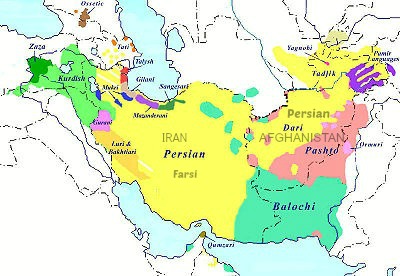Pashto, Dari, and Farsi languages are spoken in Southern and Central Asian countries. Dari, Farsi, and Pashto are all Aryan (Iranian) languages belonging to the Indo-European language family. While Dari and Farsi are two accents of the same language, Pashto is a different language. Dari, Farsi, and Pashto both use the Arabic Alphabet, but they are completely different from the Arabic language.
Where are the languages spoken?
Pashto is one of two official languages of Afghanistan; it is the national language and the lyrics of the Afghan national anthem. Dari is the other official language of Afghanistan. It is spoken as a native language in the north and west of Afghanistan and it is also a common language of communication in the capital city, Kabul.
Dari and Farsi are two accents of the same language. Dari is also called Farsi in Afghanistan while it is mostly referred to as Farsi in Iran. Farsi is also called Persian in the English language. In this article, Dari is referred to as the accent spoken in Afghanistan and Farsi is referred to as the accent spoken in Iran.
What are the differences between Dari and Farsi?
Dari and Farsi speakers can understand each other and conduct communications very easily. In general, there are few differences between formal Dari and Farsi. However, when spoken informally, the differences increase between the two accents. In other words, when watching news on TV, the difference is not very noticeable. But if an Afghan Dari speaker is in Tehran, the capital of Iran, shopping in the local market, they may face some communication problems at the beginning. These differences are more noticeable in vocabulary and pronunciation than syntax.
In comparison to Farsi, Dari uses more English borrowed words. Linguists in Iran have always tried to reduce, if not stop the influence of English terminology on Farsi. The recent developments in the medical and technology fields have resulted in introducing new terminologies most of which are in English. Farsi linguists have been working to introduce Farsi equivalents for these new terms while most of these English terms are accepted in Dari. For example, the terms such as “software, hardware, Windows, processor, etc. have their Farsi equivalents used in Iran while most of such English terms are accepted in Dari with little or no change in pronunciation.
In addition to the terminologies in the fields of medicine and technology, some words used in everyday conversations are different between the two accents. Words of various categories such as chair, eraser, hammer, and pepper are some examples that the speakers of the two accents have completely different words for and they may not understand them which can sometimes cause communication problems between the speakers of the two accents.
Pronunciation is another area where there is a salient difference between Dari and Farsi, but unlike vocabulary, it may seldom cause communication problems. The pronunciation difference between Dari and Farsi is very similar to the pronunciation difference between American English and British or Australian English.
While there are salient differences in terminology and pronunciation between Dari and Farsi, the syntax i.e. phrasal and sentence structures are the same between the two accents. That is why the speakers of the two accents understand each other with ease even if they do not understand a word or phrase in their conversation.
How does Pashto differ from Dari or Farsi?
Pashto, on the other hand, is a different language than Dari or Farsi. Speakers of Pashto and Dari may not understand each other unless they are exposed to it. However, they share the same alphabet, some words, geography, and culture. Pashto and Dari both use the Arabic alphabet which consists of 28 letters. Dari has added 4 letters of its own to the Arabic alphabet making its alphabet 32 letters and Pashto has added 12 letters to the Arabic alphabet making its alphabet 40 letters.
Since Pashto and Dari are spoken in the same geographical region, the speakers of one language are very often exposed to the other language. Most major cities in Afghanistan host both Pashto and Dari native speakers. Most Pashto native speakers in these cities speak Dari as a second language, but very few Dari native speakers may speak Pashto as their second language. Education is provided to kids in their native language and they start studying Pashto or Dari as a second language in the 4th grade.
By Faraidoon Saadat
For more DLS, check out other blogs and visit us on Facebook, LinkedIn, Instagram, or Twitter!




